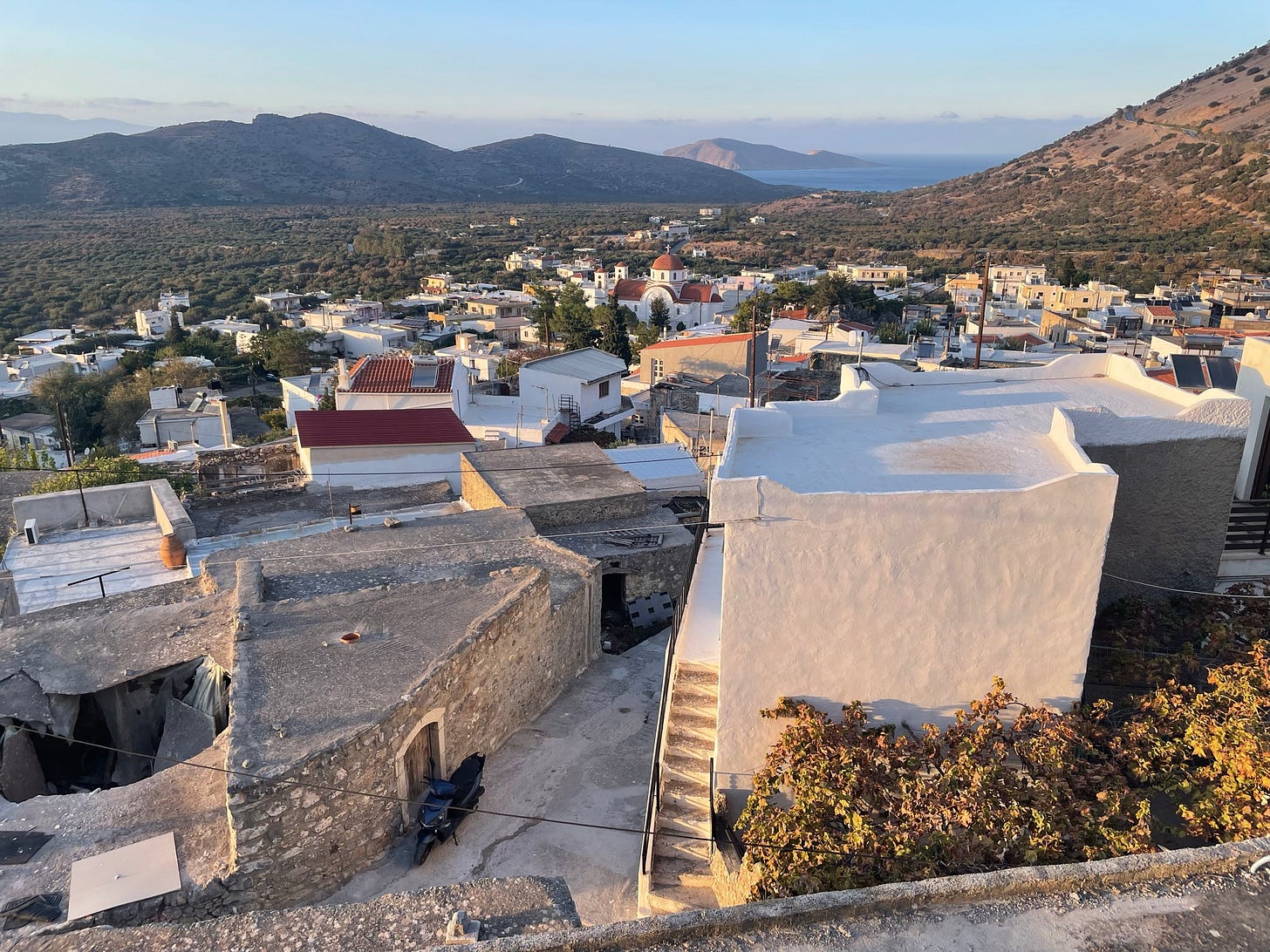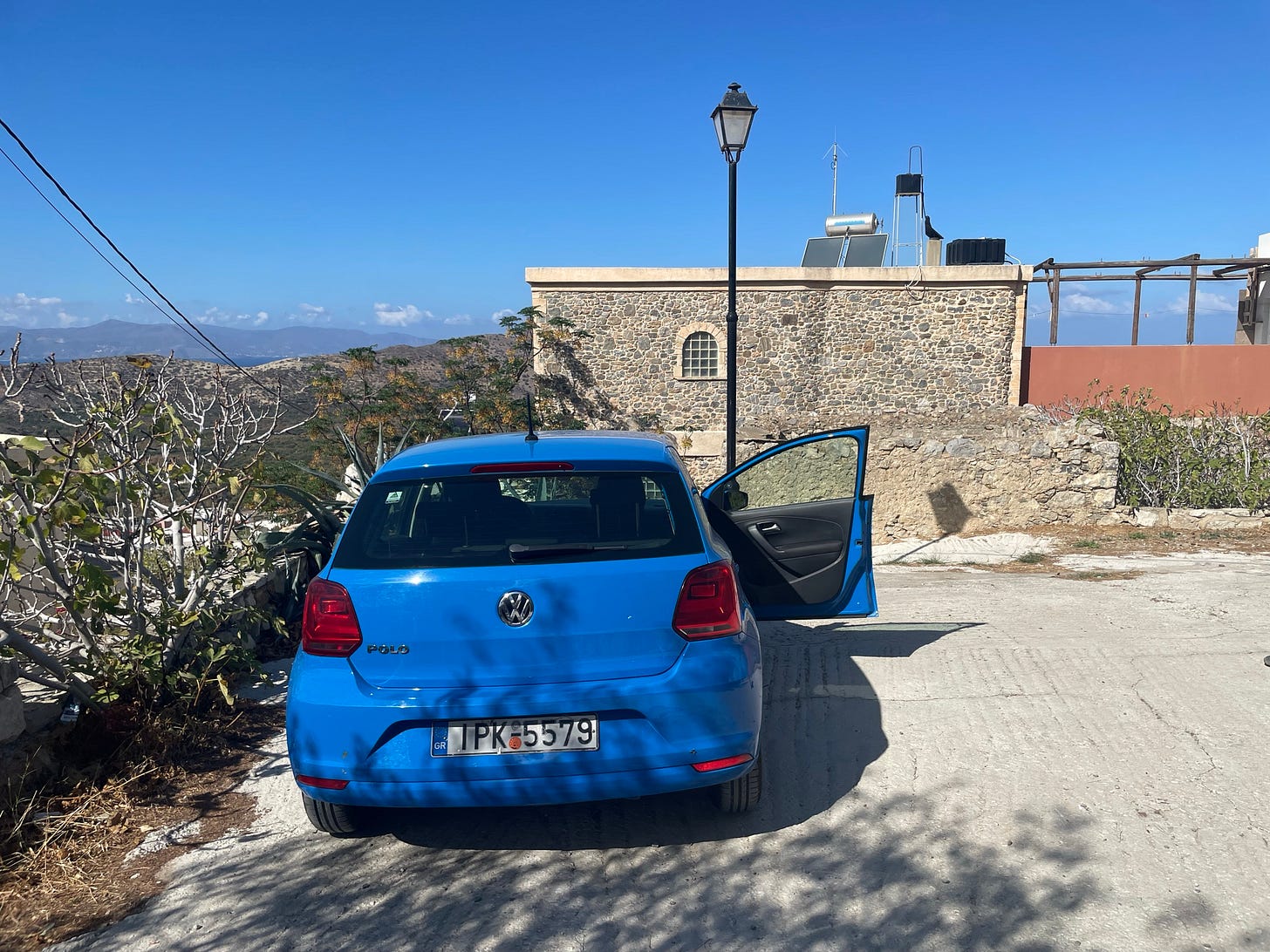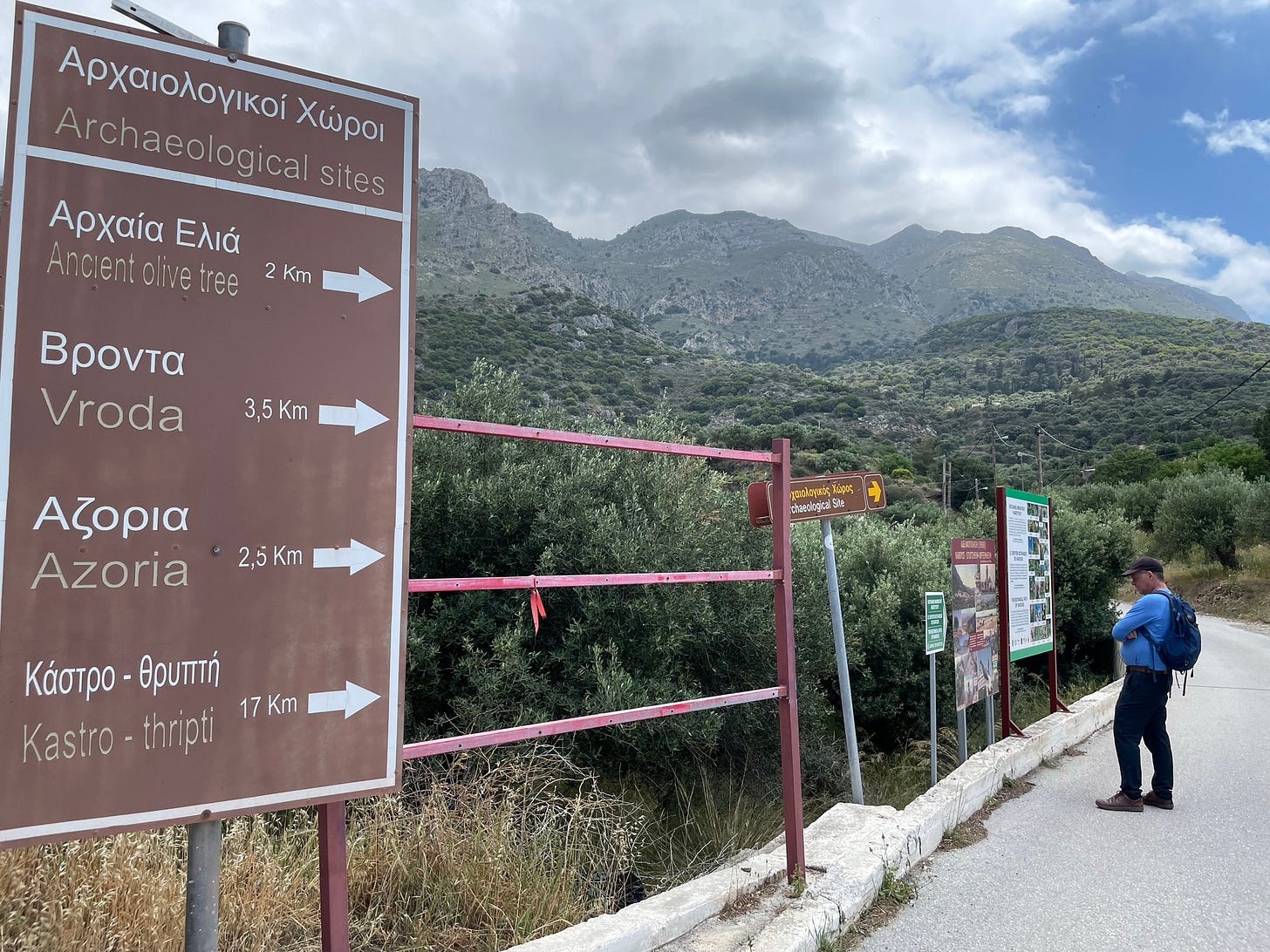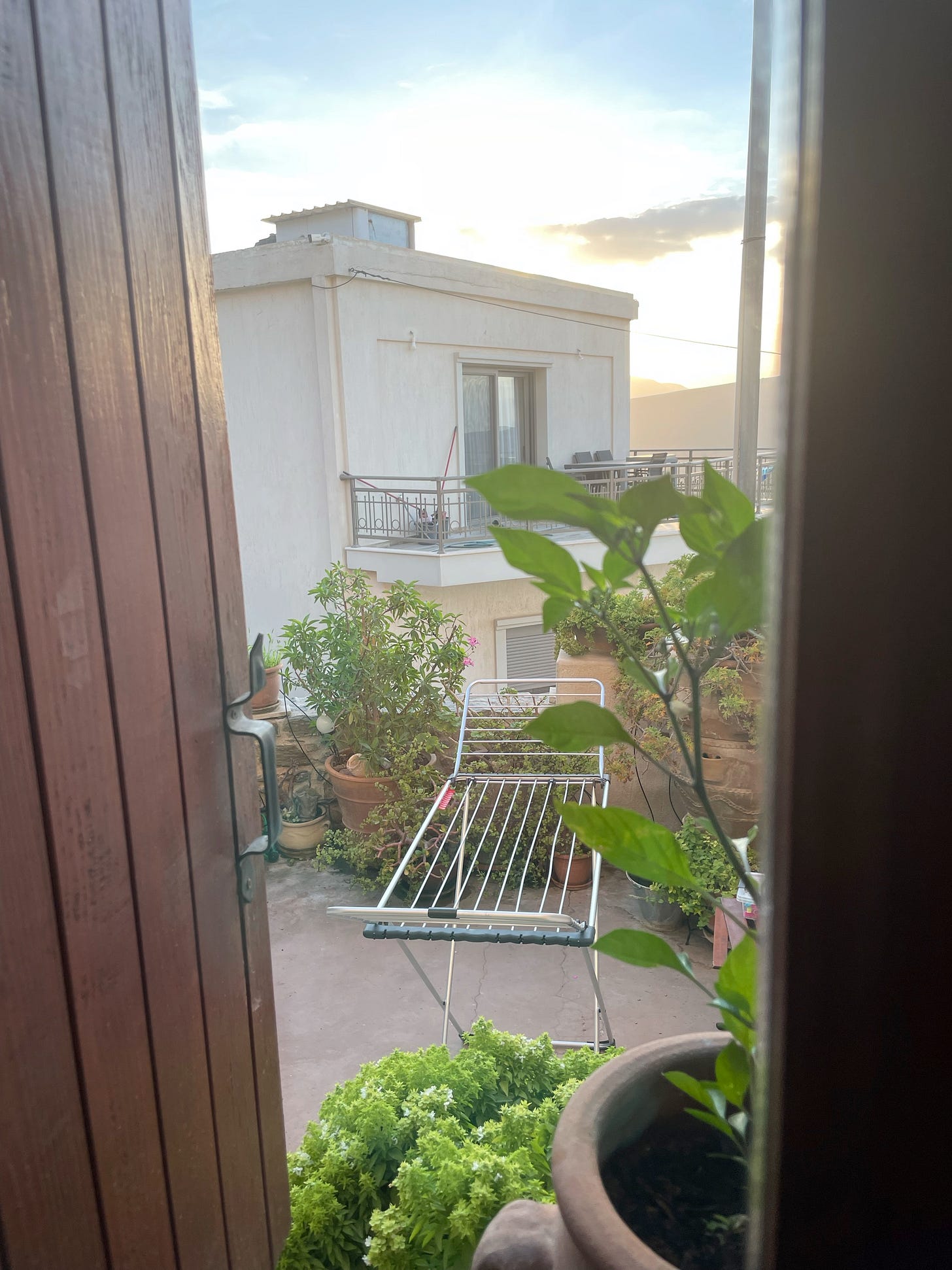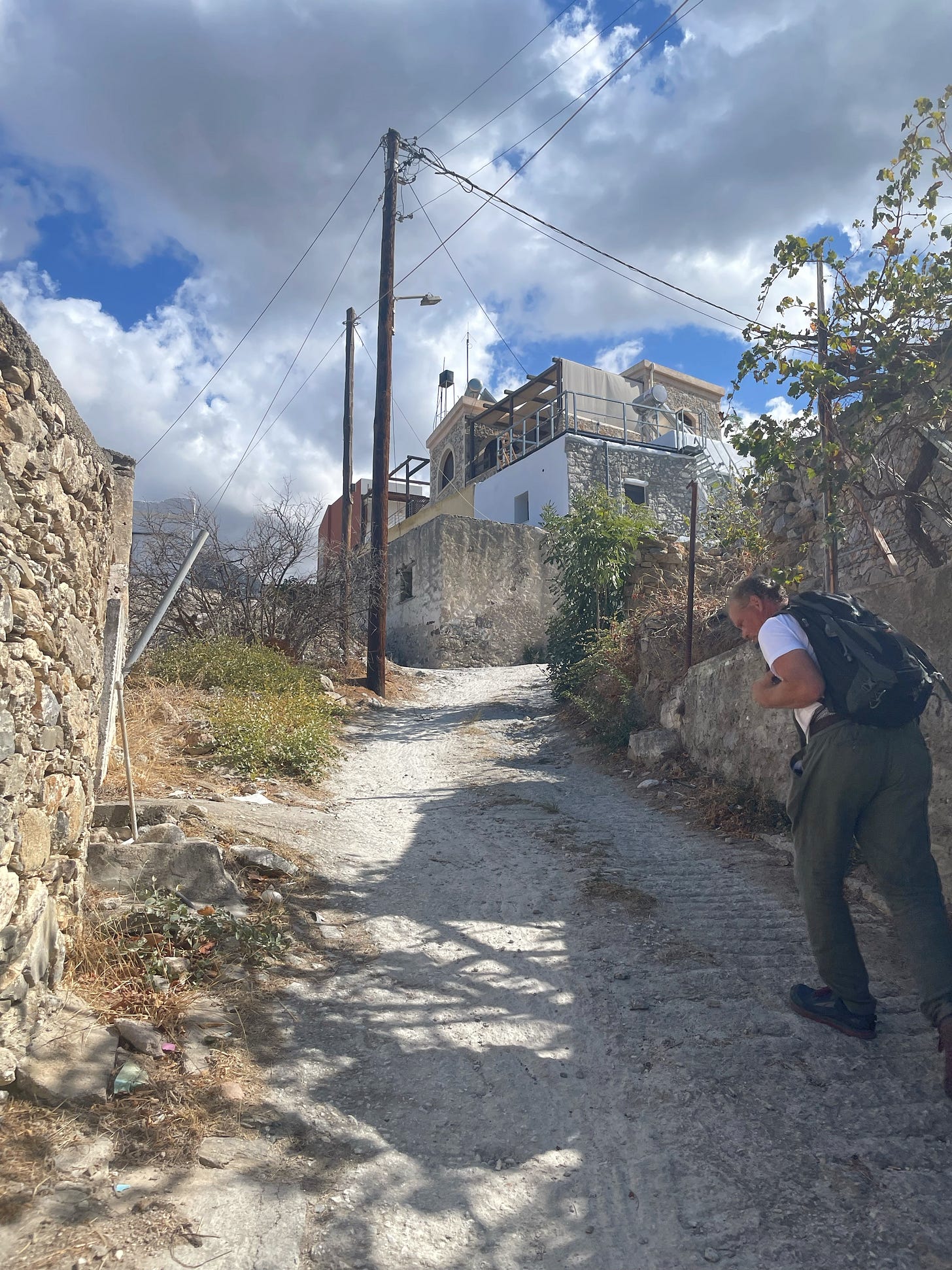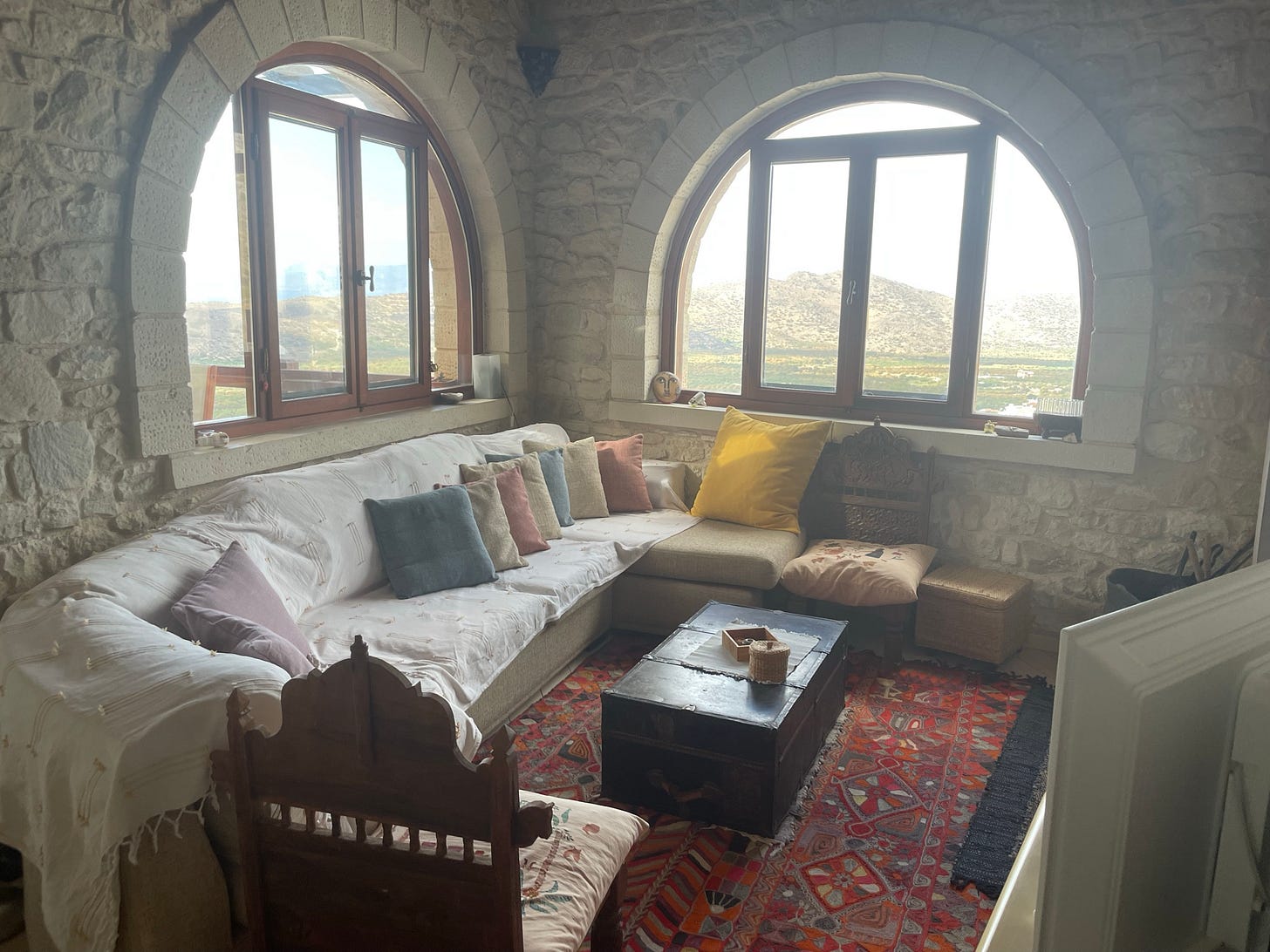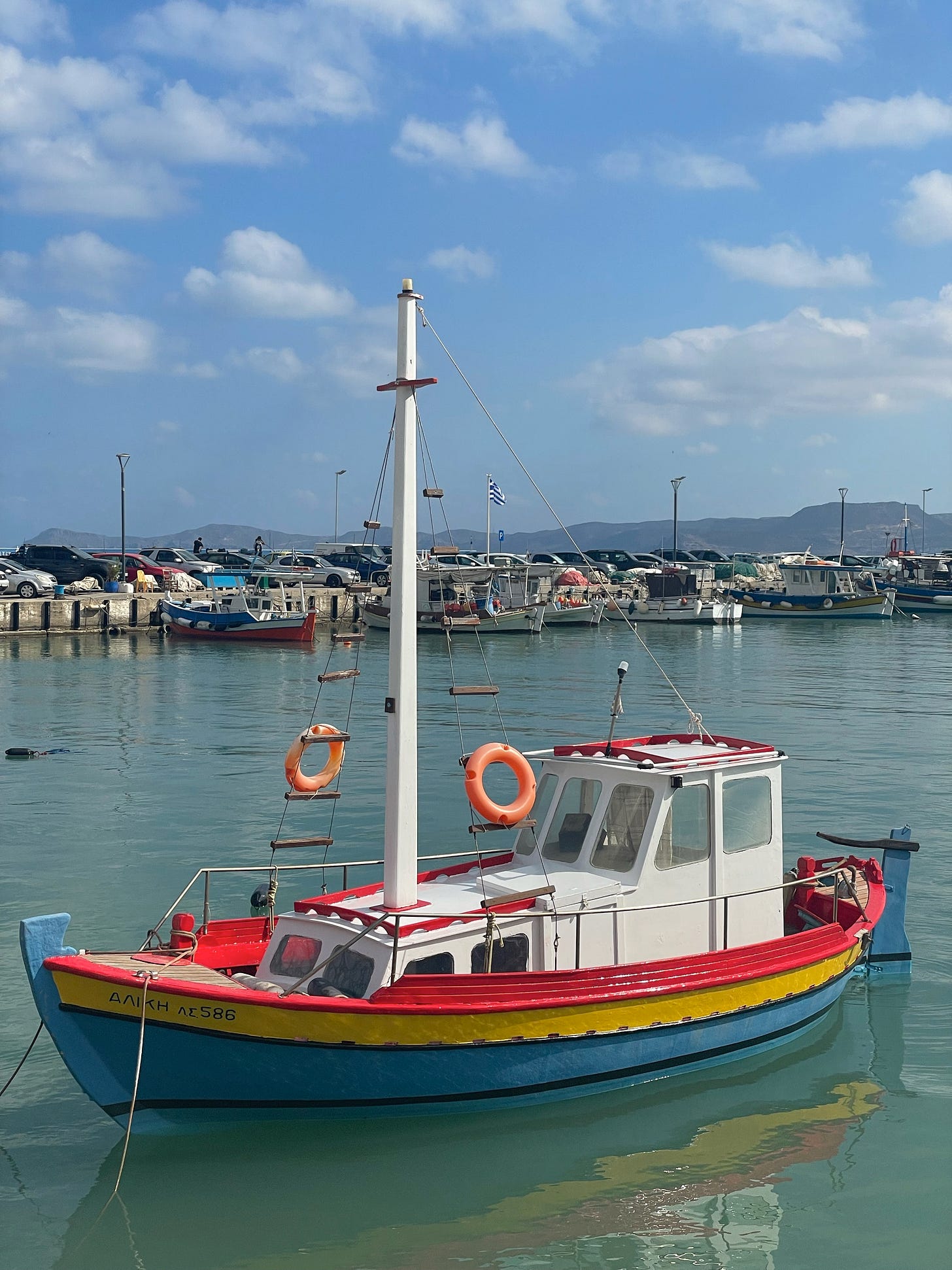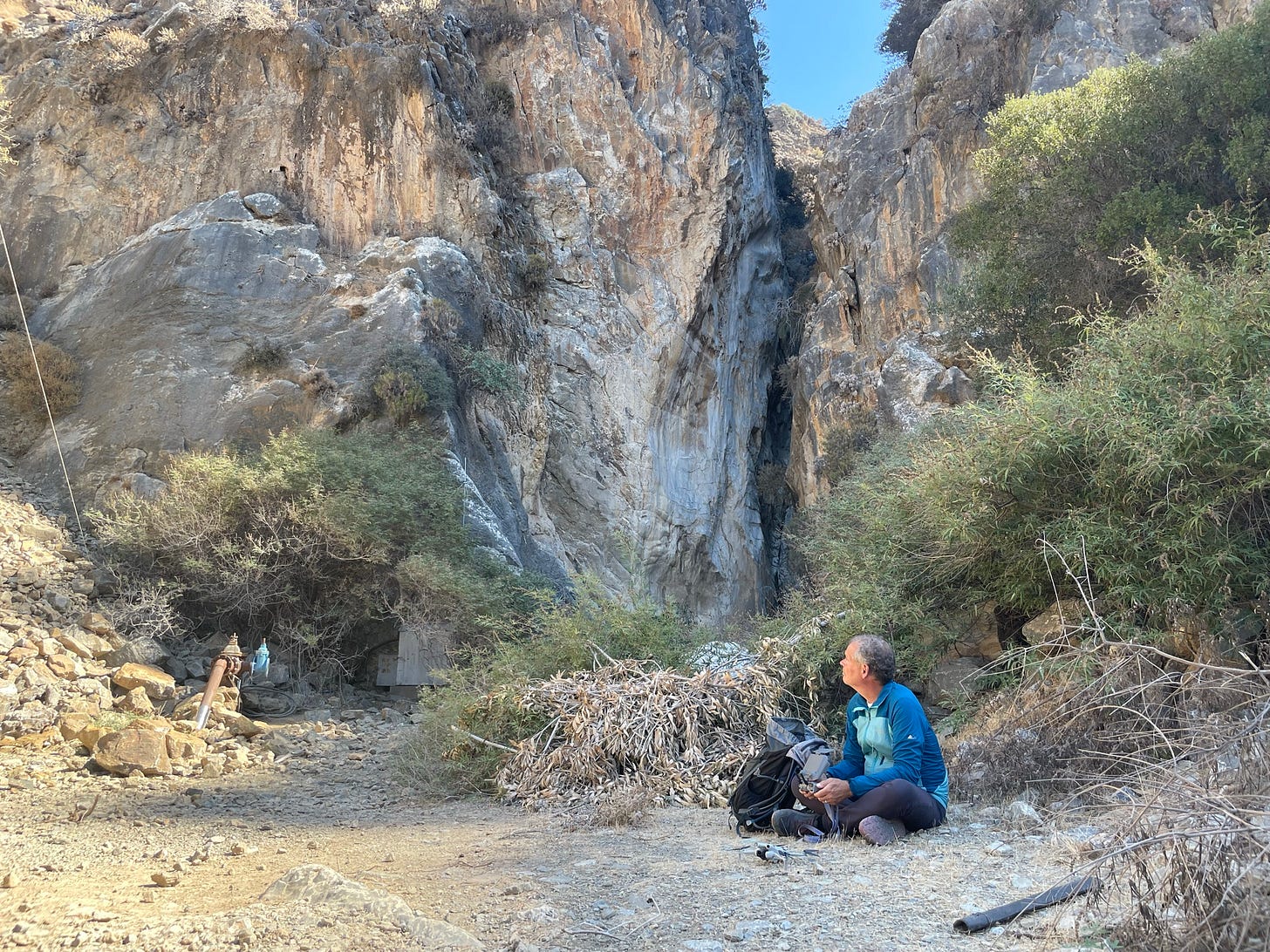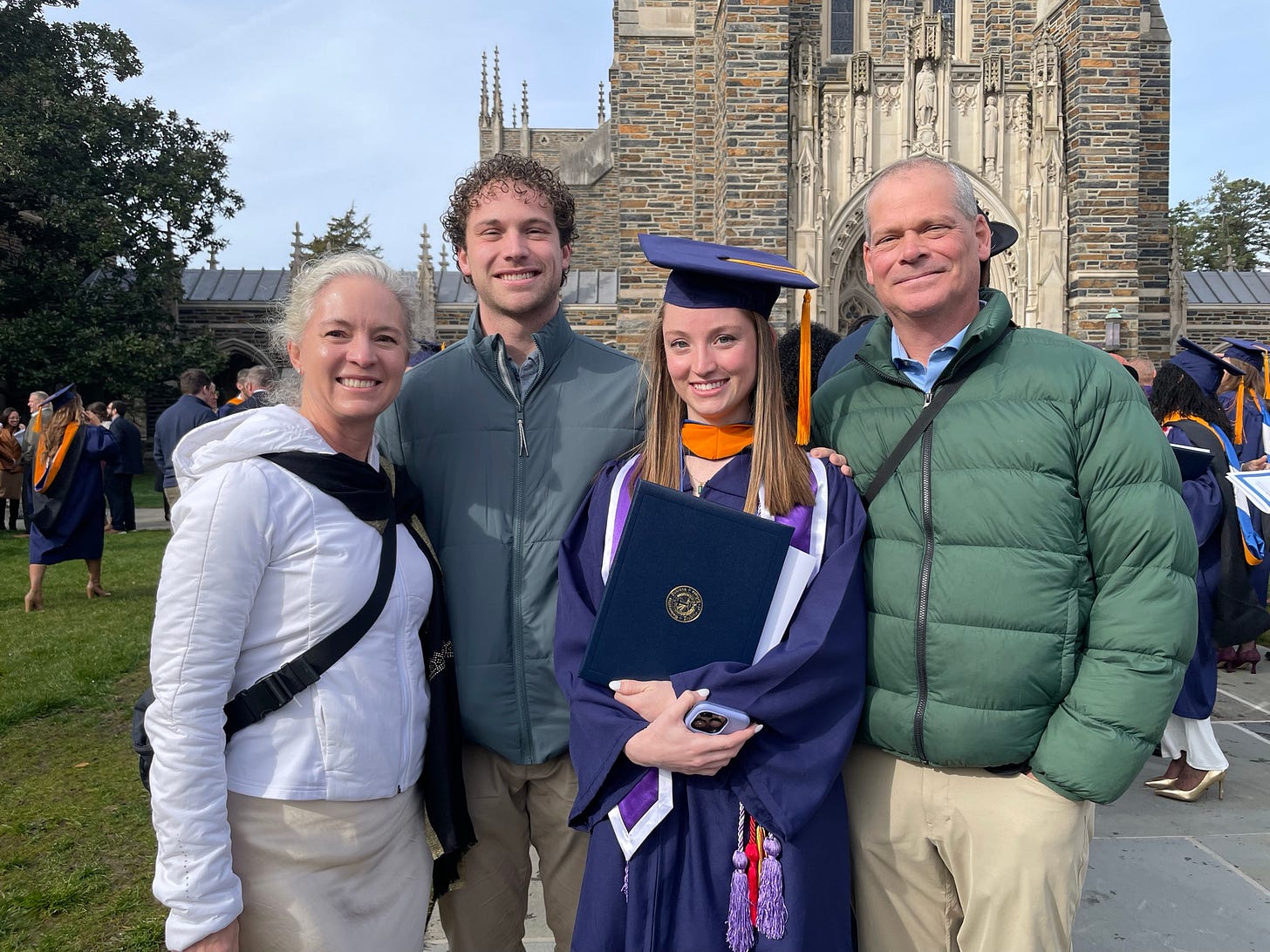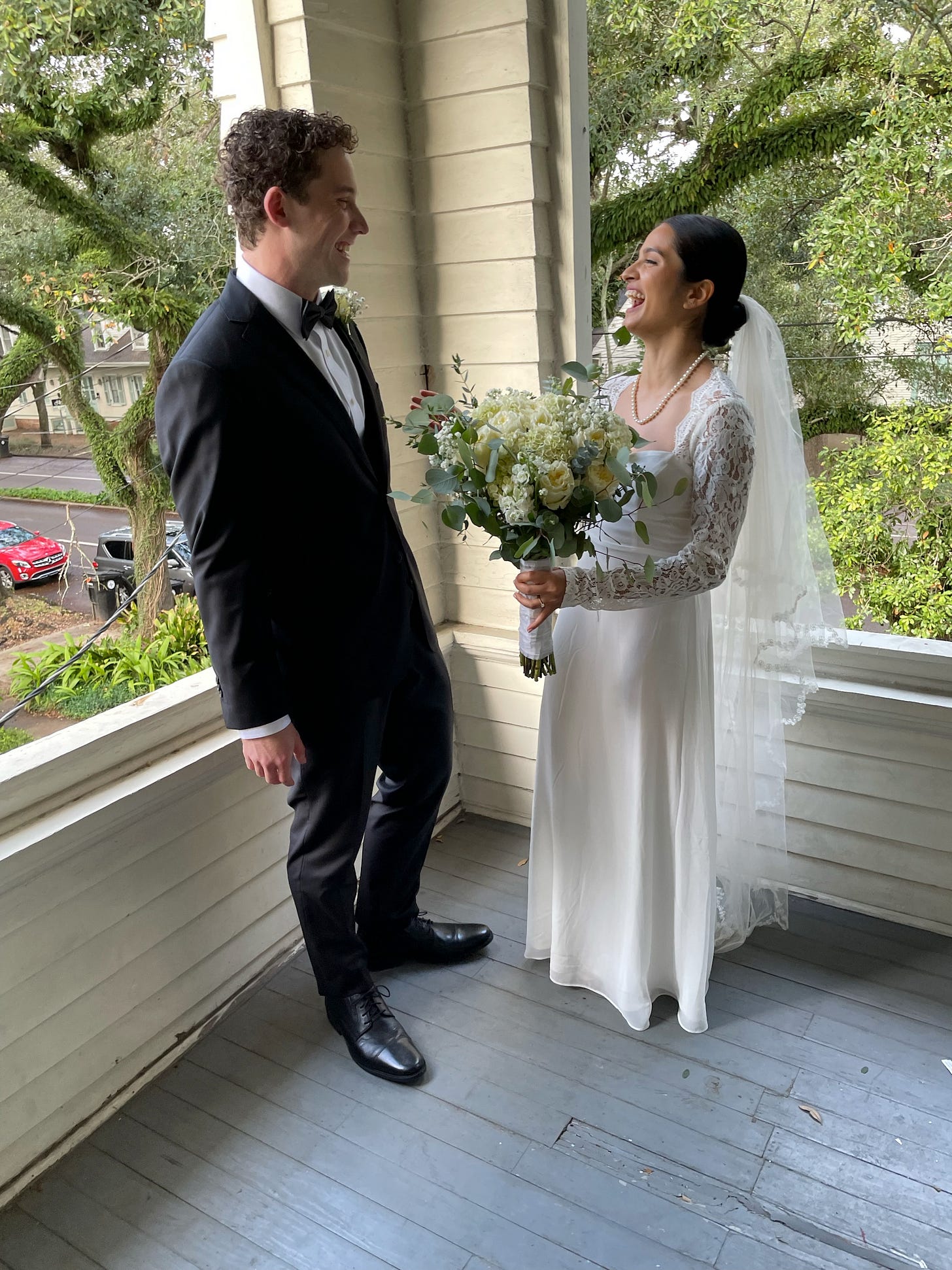Kavousi 2024: October 22-27
— Amy Hackney Blackwell, Christopher Blackwell
This is a long story, so we’ve divided it across several parts:
1. Kavousi: A Love Story (Introduction)
2. Kavousi 1990
3. Kavousi 2023
4. Kavousi 2024 ← You are here
Kavousi at sunrise
The last week of Chris’ sabbatical trip was the perfect opportunity to return to Kavousi, where we could catch up on work and explore eastern Crete. This was the first time we could live in Kavousi as modern adults–with a car, and a kitchen, and jobs.
Tuesday, October 22
We started the day in Chania, enjoying our nice hotel and its strong hot shower. After breakfast on the balcony overlooking the old town, we picked up our rented VW Polo (€259 for a week–not bad).
Our fun blue Polo parked by our house in Kavousi!
We drove out of Chania onto to the Ethniki Odo, heading east toward Heraklion and thence Kavousi. We passed countless beach resorts built on the south side of the highway; tourist wanting to visit the beach have to race across this busy road, surely an enticing proposition for families with kids or old people.
The driver who took us from Rethymno to Chania two weeks earlier had told us that this stretch of road is the most dangerous in Greece (or maybe Europe?). Thank the hordes of tourists in rental cars mixed with the drunk and the impatient. On a weekday morning, though, it wasn’t so bad.
The coast east of Heraklion is now entirely built up with vacation resorts and villas. But the road up to Agios Nikolaus is four-laned and new, and new sections were being built through the mountains as we drove through.
East of Agios Nikolaus, the road narrows down to the old two-lane highway. We rounded Mirabello Bay, passed Pacheia Ammos and the turn-off for Ierapetra, and then we were in Kavousi.
Our AirBnB hosts had given us detailed albeit baffling directions for how to reach the house. This involved driving up the road toward the Kastro and then veering off to the right, steeply up and down a gully, rounding a church, and then arriving at the parking lot next to the old apothiki. Their directions actually said, “You will think you are on the wrong path, but keep going!”
You turn here.
The road also comes to the house from the other direction, but I’m not sure that way isn’t actually too steep for a car.
The road through Kavousi is steep!
This house was the apotheosis of all our Greek rentals. A labor of love, it is huge and beautiful and filled with archaeological treatises in English, French, German, and Greek. The owner knows the people at INSTAP, the center for study of eastern Crete, and often rents the house to my old friend Donald Haggis when he comes to stay in the summers. She picks and chooses her tenants, and doesn’t rent the house often. We were lucky that it was free and that she let us stay there!
The stairs up to the living room and kitchen
Looking toward the kitchen
As always when arriving, I jumped right on to our first load of laundry.
Our dryer.
We walked down to check out the “big” grocery store, which is not exactly big but is larger than many Greek “supermarkets.” They at least had the makings of a horiatiki and sparkling waters. We had a car, so we could shop in bigger towns.
Anything we bought there, we had to carry up this slope!
That evening, we strolled down the hill back to Chez Georges for an aperitif and then had dinner at Ntakos. The proprietor there remembered us from last year. He brought out the old reception book from the early 90s. Some of my dig people were in there from 1990, but I’d never signed in personally so there was no trace of my presence.
Wednesday, October 23: Tholos Beach and Agios Nikolaus
Our view at breakfast
We had breakfast on our beautiful balcony overlooking Kavousi and Mirabello Bay. Georges had given us a large jar of local honey for free. It was so good on yogurt!
Last year, Chris had suggested that we do a “mountain to the sea” hike to simulate life on a Minoan mountaintop settlement. You can see the ocean from the Kastro, and surely people would’ve made occasional trips down there to fish and have beach parties. Fear of pirates or not, they were Greeks! (Hm. Actually, they weren’t. But they were Mediterranean, so surely they loved to have barbecues and relax by the ocean.)
The hardcore way to do this would be to start at the Kastro, walk all the way down to Tholos beach, eat some fish there and maybe cavort about like Nausicaa and her girlfriends doing laundry, and then return to the Kastro. Ideally all on the same day. Even more ideally, having slept on the Kastro the night before.
That would obviously never work. No money would persuade me to spend a night in a tent on the Kastro just so we could start our journey there. Also, any hike that passed through town in both directions would surely end at that point because we would just go home.
But life is full of compromises! We agreed that we could do this research journey on two separate days, both of which would start and end in the comfort of our house in Kavousi. Today we took the low road and walked to the beach.
The road to Tholos passes through acres of olive orchards.
Though the road to Tholos is basically flat and has almost no traffic, and it’s really not that far, it was surprisingly tiring. It takes a solid 45 minutes to reach the water. In 1990, some of us had walked down there once or twice to go to the beach, but it was too far to be a relaxing outing. We found that it didn’t feel any closer now.
Now there’s a little taverna there.
Back at my old beach?
The waves are gentle and I recall the water being quite warm, though I didn’t get in this time.
Walking back to Kavousi is ever so slightly uphill.
In need of real groceries, we spent the afternoon in the big city of Agios Nikolaus.
Now, I’d been to Ag Nik a number of times in 1990, always on the bus. All of us knew where to find the ATM, the good grocery store, the Chinese restaurant.
I have never felt so unfamiliar with a place that I once knew well. I recognized nothing. The place is now packed with tourists, seemingly all from Germany. Even in late October. It’s nothing but souvenir shops and streets lined with the same restaurants with the same touts outside.
We got ice creams at a shop by the famous inland lake, which I also didn’t remember. Could it be that the beach where I tried to swim was on the lake? Who knows. For my ice cream, I got kaimaki, which is made with mastiha from Kos and salep–a very Turkish taste and texture.
That evening, we were joined by an orange and white cat who appeared on our balcony and made herself at home.
Our cat.
Thursday, October 24: Kastro and Ierapetra
It was time to revisit the Kastro. The trail was as hard as we remembered from last year!
That trail just goes up!
Chris got some great drone videos from the top.
The site looks so much bigger when you can see it from above.
This was the first time I’d ever gotten a good aerial view of the Kastro. Drones must be a game-changer for archaeologists. In the 1980s, the only way to get aerial shots was to hire a hot-air balloon, of all things.
That evening, we met Manolis for dinner in Ierapetra. We left early to take care of a special errand.
Our son was getting married in December. Before we left on our trip, my mother had suggested that I buy his fiancée, Biruja, a wedding veil in Greece. That sounded like a great idea! Greece and wedding veils just seem to go together–in my imagination, at least. As it happened, though, we’d traveled the length and breadth of the country and seen nary a wedding veil. Maybe if we’d been a big city, but wedding stores just didn’t seem to be a thing anywhere we went.
This was our last week, so it was now or never. Some web searching revealed a couple of possibilities in eastern Crete–one in Heraklion, and one in Ierapetra!
After some minor wandering, we found the shop: Antzela. It’s not a dedicated bridal shop, more a fancy ladies’ clothing boutique.
The ladies running the place were somewhat taken aback by my request for a wedding veil, and even more when I said I wanted it then and there. But! The Greeks are a resourceful people. The owner remembered that they had a wedding veil sitting in a cabinet in the back. Her daughter excavated it and modeled it for us.
This veil was perfect!
It was exactly what I wanted–just ankle length, simple but very Greek looking.
Veil literally in the bag, we met Manolis for dinner at Cleio’s, run by his friend Cleio. It was great to see him again. When I told him about the eroded state of the trail up to the Kastro, he lamented that the kalderini hasn’t been maintained. Cutting dirt roads through it causes it to break down.
Cleio gave us the customary free sweet after our meal. Her husband had made Ypovrichio, or submarines–spoons of a sweet paste flavored with mastic submerged in a glass of water. It’s kind of like a chewy lollipop.
This is the second time in two days that I’ve mentioned mastic. Mastic, or mastiha, is a solid plant resin from the mastic tree, Pistacia lentiscus. It comes from the island of Chios, which has made a living out of the stuff for thousands of years and still does today; everyone in Greece knows that mastiha comes from Chios. It tastes kind of piney.
I like Ierapetra better than Agios Nikolaus. It seems more natural, less set up for tourism. Also, it’s quicker to drive there from Kavousi.
The sun going down in Ierapetra.
Friday, October 25: Cave of Zeus
Starting the day with a nice breakfast!
The previous year, we were riding in a car climbing up the mountains high above the Gulf of Corinth when we happened to tell our driver, Demetrios, that we’d come from Crete. Crete! Oh, he had a video we must see!
Demetrios immediately diverted his attention from negotiating a winding mountain road next to a 500-foot drop-off into the ocean to searching through his phone for this video. It turned out that when he’s not driving a car, he is a professional drummer. He’d participated in a traditional music performance in the Cave of Zeus (pronounced “Zefs”). Evidently Zeus was born on Crete and raised in this cave. We must see it when we returned to Crete!
Well, we were back in Crete, so maybe it was time to see this famous cave!
Why I thought it wouldn’t be a massive tourist trap, I don’t know.
Anyway! We headed out toward Agios Nikolaus but then cut off into the mountains to the west. Up and up we wound. We stopped for coffee at a roadside stand/tourist souvenir shop, where the proprietor showed us a video of his resin woodworking technique and succeeded in persuading us that we needed to own some of his productions.
After some more driving in the remotest of mountains, we emerged onto the Lasithi plateau, famed for its old wood and cloth windmills. Does any serious farmer still use these things? Surely not. In late October, lots of the cloth had fallen to bits and was just handing in shreds on the wooden frames. I imagine they redo them at the start of tourist season in the spring.
The Lassithi plateau; I didn’t bother to take pictures of those fake windmills.
The Diktaean Cave is located in the town of Psychro. The entrance is above a parking lot full of the usual tourist schlock. In the summer, the place must be mobbed with buses–you can book a tour of the whole Lasithi Plateau, which will take you to see the windmills too.
On a gray weekday in late October, parking wasn’t a big deal. Though it is possible that the parking lot was empty partly due to the fact that the cave was closed that day.
Sorry, folks, park’s closed!
I should know by now always to check these things before setting out.
For what it’s worth, the Diktaean cave looks like it might be an interesting cave to visit, at least in the spelunking sense. Even though I’m not convinced that Zeus ever lived there. Like most sites in Crete, it’s best enjoyed by the nimble and sure-footed.
On the way home, we stopped at the Sklavenitis in Agios Nikolaus to buy Friskies for our balcony cat.
Our comfy living room. That night, inspired by a Halloween-season retrospective essay in the WSJ, we sat in there and watched The Omen.
Saturday, October 26: Sitia and Kato Zakros
For our last Saturday in Greece, I wanted to show Chris a better time than I had the day before, with our fail-venture to the cave of Zefs. This time, we headed east.
The highway east of Kavousi looks much like it did in 1990. It’s two lanes all the way, winding around the sides of mountains. If you end up behind a truck, you go that truck’s speed until it leaves the road.
We stopped for coffee in the eastern town of Sitia. Sitia used to be famous for a pelican that hung around the harbor, but it’s not there anymore.
Sitia’s harbor
One of many sailboats in Sitia.
The far eastern end of Crete isn’t very developed or much visited. It takes some serious driving to get out here, which would discourage package tourists and even self-caterers.
Our objective was Kato Zakros, where we could visit the Minoan site of Zakros and the so-called Gorge of the Dead.
This gorge is an interesting site. The E4 trail goes through it, from the hill village of Zakros all the way to the tiny town of Kato Zakros on the coast.
The Minoans used to bury people in caves on the gorge’s sides.
Kato Zakros is on the far eastern coast, looking out toward Cyprus.
We drove back by way of the south coast. For anyone who enjoys driving on deserted, winding mountain roads, you can’t do much better.
The south coast is getting more and more built up with tourist amenities, though many places still seem rough.
We stopped at the Sklavenitis in Ierapetra on the road back to Pacheia Ammos. This is where we should shop from now on; it’s closer than Ag Nik and much easier to get in and out of.
Sunday, October 27: Kavousi
Sunday morning dawned with church bells a’ringing.
This was our last lazy Sunday in Greece. The time had changed overnight; daylight savings time had ended. (It would end again in the U.S. the following Sunday, which meant we were jet lagged for weeks.)
Over an entire summer of eating at the Pharangi taverna every day, I never once asked why the place was named “the canyon.” This being our last opportunity to rectify my youthful ignorance, we walked out to see the famous gorge.
Chris sitting at the mouth of the gorge.
We climbed partway up the trail.
That gorge really is right next to Kavousi. Who knew!
We had a last Sunday lunch at the local tavernas. There were a surprising number of tourists still hanging around at the tail end of October.
Last Fix Anef beer, but with lemon!
Monday, October 28: Homeward bound
We left the next day. It was just as well; another cat had started moving in, and we needed to nip that in the bud.
We’d planned to visit Knossos on the way to the airport, but it was mobbed with tourists. Like I said, I’m glad I saw it in 1990, because I doubt I ever will again.
And then….
The wheel has come full circle, or something like that. 1990 evidently was a very important year for our family. So was 2024.
Right after Chris and I flew back from Greece, we returned to Duke for our daughter’s graduation.
Duke chapel, this time with graduates of Duke nursing school!
Our son got married in New Orleans. The bride wore a wedding veil from Crete.
All the most fashionable brides shop in Ierapetra.
I’ve now seen Kavousi in May, June, July, August, and October. I’ve seen the Kastro dry and dusty, covered with wildflowers, and just starting to brown up for winter. I’ve seen it crawling with humans and utterly deserted. I’m delighted that Chris wanted to return after his first visit.
And though neither Chris or I can claim to be an archaeologist of any description, our return to Kavousi was the ideal finish for a sabbatical project intended to feel the texture of the landscape in real time. Though much changes, much abides. Crete remains sunbaked, rocky, and steep. We can still walk to the Kastro on a trail made by Turks to improve a footpath walked by Minoans, enhanced with dirt roads made by 20th-century Cretans. To get a sense of what it means to be a human in the physical world, we could do a lot worse than that.
This is a long story, so we’ve divided it across several parts:
1. Kavousi: A Love Story (Introduction)
2. Kavousi 1990
3. Kavousi 2023
4. Kavousi 2024 ← You are here




